 |
DEPARTMENT
RESULTS |
|
|
|
Goal: Maximize use of a state-of-the-art human resource management system |
|
Why
is this goal important?
Constant measuring of the Human Resource System’s effectiveness and
efficiency is essential to ensuring the necessary staff and staffing levels
for the Executive Branch.
How will this goal be accomplished?
The Department of Employee Relations (DOER) is
measuring and tracking three indicators covering the Human Resource
Management system.
T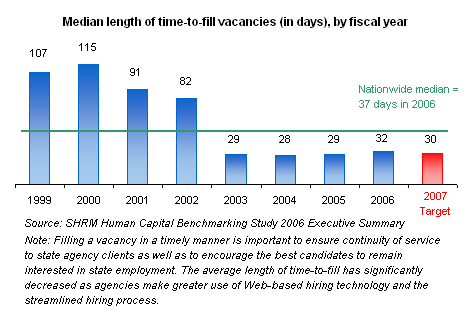 hese indicators illustrate how well DOER is delivering
its human resource products and services to the executive branch of state government. hese indicators illustrate how well DOER is delivering
its human resource products and services to the executive branch of state government.
The first two indicators measure
the success of DOER’s
streamlined, Web-based hiring process that was implemented in 2002. This process
allows agencies to rapidly post vacant positions and applicants to easily
apply for jobs. The third
indicator measures the cost of human resources per employee. It is a
critical step to identifying the efficiency and the value of the human
resource system. State data for this study is compared to a national average
of HR costs.
What is DOER’s progress to
date?
Minnesota state agencies have reallocated
staff and funds to improve service and have seen a decrease of 7.7% in the
cost of HR services per employee from 2001 to 2006. This level remains below
the national average for governmental employers. DOER has met its goal of
reducing the time-to-fill average job vacancies to below the national
average. It has also met its goal of filling all competitive, unlimited
classified positions through the multi-source hiring system.
|
|
Goal:
Achieve market-competitive compensation plans to ensure a skilled workforce
of effective size |
|
Why is this goal important?
The state is committed to the development and maintenance of inclusive
employment practices. A workplace that respects and values the productivity
and contributions of a diverse workforce ensures that all positions are
equally accessible to all qualified persons. By doing this, the state
benefits from the abilities and talents of qualified members of protected
groups, including women, minorities and individuals with disabilities. A way
to measure this goal is by monitoring the state’s ability to retain
employees as shown by a low turnover rate.
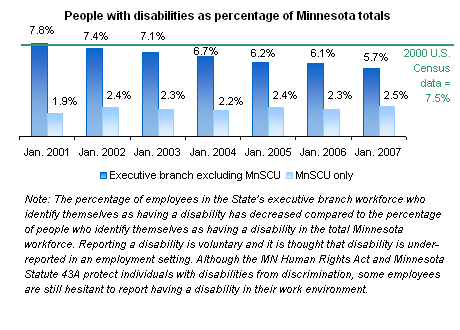
How will this goal be accomplished?
DOER measures the percentage of protected-group members (women, minorities
and persons with a disability) in the State’s executive branch workforce as
compared to protected-group members in Minnesota’s employed labor force.
This measure indicates the state standings in achieving parity between its
government workforce and Minnesota’s employed
labor force.
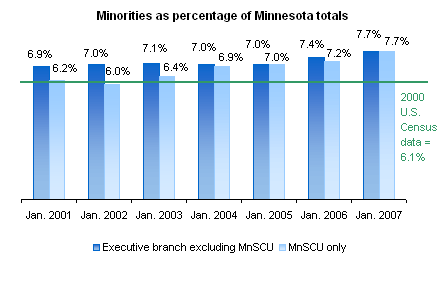 DOER also measures the
number of state employees who voluntarily leave state employment. Employee
turnover for the public sector is typically lower than for the private
sector. However, Minnesota state government has a turnover rate that is even
lower than that of most other states. Low employee turnover provides a
general indication that employees are satisfied with their employment. DOER also measures the
number of state employees who voluntarily leave state employment. Employee
turnover for the public sector is typically lower than for the private
sector. However, Minnesota state government has a turnover rate that is even
lower than that of most other states. Low employee turnover provides a
general indication that employees are satisfied with their employment.
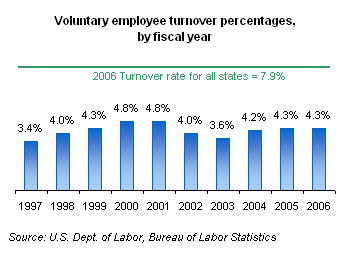 What
is DOER’s progress to date? What
is DOER’s progress to date?
DOER has measured the percentage of protected-group members in the state’s
workforce as compared to the protected-group members in Minnesota’s employed
labor force. The state continues to experience a low level of turnover.
However, a significant number of state employees will be eligible to retire
over the next ten years. With an expected imminent increase in the level of
voluntary turnover the state will need to further address this issue.
Learn more at:
 DOER’s Office of Diversity and Equal Opportunity:
http://www.doer.state.mn.us/odeo/ ODEO.htm
DOER’s Office of Diversity and Equal Opportunity:
http://www.doer.state.mn.us/odeo/ ODEO.htm
|
|
Goal:
Effectively administer a cost-efficient benefit program for the state and
its employees |
|
Why
is this goal important?
As the administrator of the state’s employee insurance benefit programs it
is critical that DOER provide suitable benefits to attract and retain
high-quality employees while effectively managing increasing benefits costs. increasing benefits costs.
How will this goal be accomplished?
DOER
has been tracking and comparing the national rates of health care cost
increases as compared to the State’s projected rate of health care cost
increases. Moreover, DOER is working to minimize risk and gain improvements
in employee health and productivity while effectively managing costs.
What is DOER’s progress to
date? 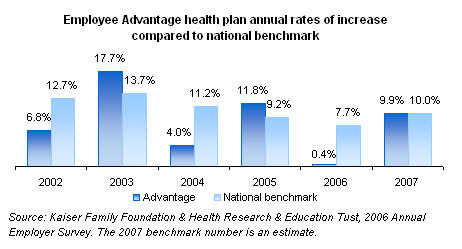
The
Minnesota Advantage Health Plan for
state employees has had annual rates of
increase lower than the national average in three of the last five years. In
2006, the health insurance premium charged for the Advantage program
increased by 0.4%, compared to the national average of 7.7%. The program was
able to hold premiums to a 9.9% increase in 2007, which is on track with the
projected national average increase.
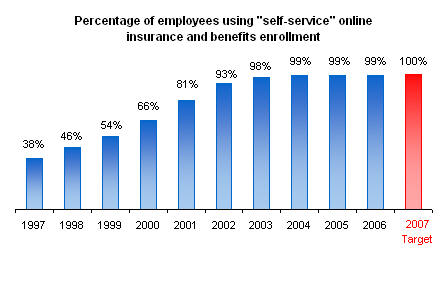 DOER continues to monitor the percentages of the
employees using “Self-Service” online insurance and benefits enrollment.
The
cost of Web-based enrollment is less expensive than
paper-based processes
and provides employees with better service by having all information be
up-to-date. DOER has been able to increase the number of employees who
enroll on-line to 99% over the 38% who enrolled online in 1997. Although
DOER continues to strive for 100% online enrollment there are situations
which make this difficult to achieve. For example, employees on foreign
travel, unexpected leaves of absence and other situations will continue to
require a manual enrollment process for some time to come. DOER continues to monitor the percentages of the
employees using “Self-Service” online insurance and benefits enrollment.
The
cost of Web-based enrollment is less expensive than
paper-based processes
and provides employees with better service by having all information be
up-to-date. DOER has been able to increase the number of employees who
enroll on-line to 99% over the 38% who enrolled online in 1997. Although
DOER continues to strive for 100% online enrollment there are situations
which make this difficult to achieve. For example, employees on foreign
travel, unexpected leaves of absence and other situations will continue to
require a manual enrollment process for some time to come.
DOER's Workers' Compensation program
continues to hold costs to levels below the average for businesses in
Minnesota.
| |
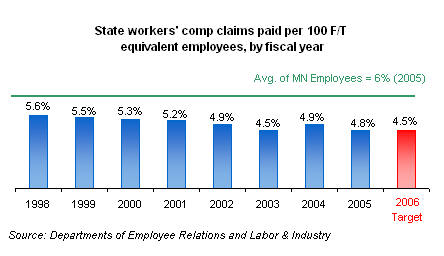
|
 |
 |
Learn more at:
 Advantage Health Plan:
http://www.doer.state.mn.us/ei-segip/health.htm
Advantage Health Plan:
http://www.doer.state.mn.us/ei-segip/health.htm
 State’s Workers’ Compensation Program:
http://www.doer.state.mn.us/ei-wc/eidwc.htm
State’s Workers’ Compensation Program:
http://www.doer.state.mn.us/ei-wc/eidwc.htm
 DOER’s Total Absence/Risk Management Unit:
http://www.doer.state.mn.us/ei-gen/Mgmt.htm
DOER’s Total Absence/Risk Management Unit:
http://www.doer.state.mn.us/ei-gen/Mgmt.htm
|
|
Some images © 2003 www.clipart.com |
|
Last update on
07/30/2007
|
|


 hese indicators illustrate how well DOER is delivering
its human resource products and services to the executive branch of state government.
hese indicators illustrate how well DOER is delivering
its human resource products and services to the executive branch of state government.
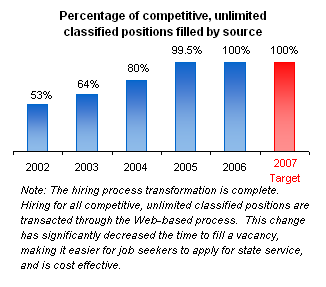
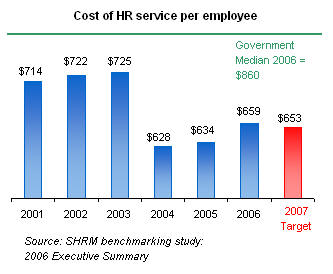

 DOER also measures the
number of state employees who voluntarily leave state employment. Employee
turnover for the public sector is typically lower than for the private
sector. However, Minnesota state government has a turnover rate that is even
lower than that of most other states. Low employee turnover provides a
general indication that employees are satisfied with their employment.
DOER also measures the
number of state employees who voluntarily leave state employment. Employee
turnover for the public sector is typically lower than for the private
sector. However, Minnesota state government has a turnover rate that is even
lower than that of most other states. Low employee turnover provides a
general indication that employees are satisfied with their employment. 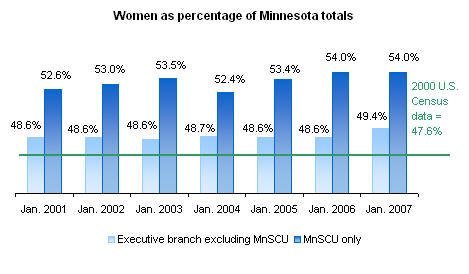

 increasing benefits costs.
increasing benefits costs.
 DOER continues to monitor the percentages of the
employees using “Self-Service” online insurance and benefits enrollment.
The
cost of Web-based enrollment is less expensive than
paper-based processes
and provides employees with better service by having all information be
up-to-date. DOER has been able to increase the number of employees who
enroll on-line to 99% over the 38% who enrolled online in 1997. Although
DOER continues to strive for 100% online enrollment there are situations
which make this difficult to achieve. For example, employees on foreign
travel, unexpected leaves of absence and other situations will continue to
require a manual enrollment process for some time to come.
DOER continues to monitor the percentages of the
employees using “Self-Service” online insurance and benefits enrollment.
The
cost of Web-based enrollment is less expensive than
paper-based processes
and provides employees with better service by having all information be
up-to-date. DOER has been able to increase the number of employees who
enroll on-line to 99% over the 38% who enrolled online in 1997. Although
DOER continues to strive for 100% online enrollment there are situations
which make this difficult to achieve. For example, employees on foreign
travel, unexpected leaves of absence and other situations will continue to
require a manual enrollment process for some time to come. 

